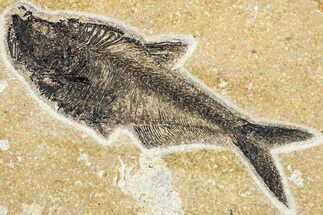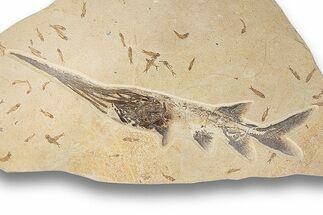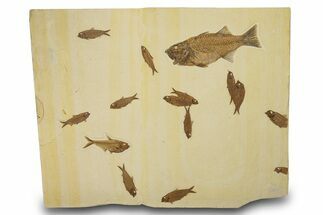46" Plate of Four Fossil Fish (Diplomystus & Knightia) - Wyoming
Due to the size and weight of this piece it will be shipped on a pallet or in a crate via freight. Our website cannot automatically calculate freight shipping costs, so these costs will be calculated and billed after purchase. Please contact us prior to purchase if you need a shipping quote.
This is a beautifully prepared, natural fossil fish association containing a 14.3" long Diplomystus dentatus and three Knightia eocaena at 6.7", 6.15", and 5.6". This specimen was collected from the Green River Formation, specifically, the "gastropod layer" at Lindgren Quarry near Kemmerer, Wyoming. They are nicely spread out across on a 46 x 21.2" rectangular-cut slab of shale. There is a fossil plant limb beneath the upper layers of the rock, indicated by the long depression that runs from the top to the bottom of the plate.
The specimen is backed for stability and is accompanied by wall hanging hardware.
Diplomystus is an extinct genus of freshwater, ray-finned predators that are distantly related to modern herrings and sardines. Diplomystus has a distinctive jaw that protrudes aggressively outward from the mouth at an angle that allowed it to feed in surface waters and devour such prey as the smaller, schooling Knightia.
50 million years ago in the Eocene (55.8 mya to 33.8 mya), D. dentatus thrived in lakes fed by the Uinta and Rocky Mountain highlands. D. dentatus is uniquely entombed in the fine-grained lime mud of Fossil Lake.
The anoxic conditions at the bottom of Fossil Lake slowed bacterial decomposition, prevented scavengers from disturbing corpses, and, most interestingly, suffocated creatures that ventured into the oxygen-starved aquatic layer. The result is a miraculous exhibition of Eocene biota in a subtropical aquatic community within sycamore forests, teeming with creatures such as freshwater stingrays, dog-sized horses, menacing alligators, early flying bats, and one of the first primates.
By the end of the Eocene, Earth developed icehouse climate characteristics and had a change in atmospheric chemistry. The effects of bolide impacts may also have contributed to the eventual loss of flora and fauna at once verdant latitudes.
Today the wonderfully preserved fossils of Diplomystus and other Fossil Lake fauna are collected in several private quarries around Kemmerer, Wyoming. The best preserved fish fossils come from the coveted 18 Inch Layer. This layer is collected at night under high-powered lights, enhancing the faint signs of fish under the surface indicating underlying fossils. These “ghosted” fish then must go through many hours of manual preparation to remove the overlying rock and reveal the Green River fauna in all of its glory.
50 million years ago in the Eocene (55.8 mya to 33.8 mya), D. dentatus thrived in lakes fed by the Uinta and Rocky Mountain highlands. D. dentatus is uniquely entombed in the fine-grained lime mud of Fossil Lake.
The anoxic conditions at the bottom of Fossil Lake slowed bacterial decomposition, prevented scavengers from disturbing corpses, and, most interestingly, suffocated creatures that ventured into the oxygen-starved aquatic layer. The result is a miraculous exhibition of Eocene biota in a subtropical aquatic community within sycamore forests, teeming with creatures such as freshwater stingrays, dog-sized horses, menacing alligators, early flying bats, and one of the first primates.
By the end of the Eocene, Earth developed icehouse climate characteristics and had a change in atmospheric chemistry. The effects of bolide impacts may also have contributed to the eventual loss of flora and fauna at once verdant latitudes.
Today the wonderfully preserved fossils of Diplomystus and other Fossil Lake fauna are collected in several private quarries around Kemmerer, Wyoming. The best preserved fish fossils come from the coveted 18 Inch Layer. This layer is collected at night under high-powered lights, enhancing the faint signs of fish under the surface indicating underlying fossils. These “ghosted” fish then must go through many hours of manual preparation to remove the overlying rock and reveal the Green River fauna in all of its glory.
Knightia is an extinct genus of schooling, ray-finned, spindle-shaped, bony fish that shares a family with herrings and sardines. They lived in the freshwater (lacustrine) environments of North America and were eaten by just about everything that was bigger. They ate insects and smaller fish, and used gill rakers to feast on plankton. Knightia eocena is the largest of the three species of Knightia, with a typical length of about 15 centimeters. It is the state fossil of Wyoming.
These fish had rows of dorsal and ventral scutes running from the back of the head to the medial fins. They had heavy scales, and small conical teeth. They are popular finds in the Wyoming lagerstätte, and were a primary food source to the large and hungry vertebrates of that once hunted the Green River Formation.
The Green River Formation is an Eocene-aged geologic formation that records the sedimentation in a group of intermountain lakes in three basins along the present-day Green River in Colorado, Wyoming, and Utah. The Eocene spanned approximately 55.8 to 33.8 million years ago. This formation has distinct stratigraphy that displays alternating light and dark layers representing seasonal erosion and deposition.
Freshwater basins, charged by the Uinta Mountains on the Wyoming-Utah border, contained an enormous representation of taxa. The beginning of the Eocene was marked by warm upper latitudes, a greenhouse atmosphere rich in methane and carbon dioxide, and local climates stabilized by large lakes populated by such creatures as crocodiles. Fossil Lake in Wyoming, of which the Green River Formation includes, is known for its well-preserved warm, lacustrine ecology.
The end of the Eocene was dramatically different, with the onset of icehouse climate characteristics, a change in atmospheric chemistry, and possible bolide impacts. The Green River fossils date about 48 million years, but cover several million years, including the transition between the moist early Eocene climate and the slightly drier mid-Eocene.
These fish had rows of dorsal and ventral scutes running from the back of the head to the medial fins. They had heavy scales, and small conical teeth. They are popular finds in the Wyoming lagerstätte, and were a primary food source to the large and hungry vertebrates of that once hunted the Green River Formation.
The Green River Formation is an Eocene-aged geologic formation that records the sedimentation in a group of intermountain lakes in three basins along the present-day Green River in Colorado, Wyoming, and Utah. The Eocene spanned approximately 55.8 to 33.8 million years ago. This formation has distinct stratigraphy that displays alternating light and dark layers representing seasonal erosion and deposition.
Freshwater basins, charged by the Uinta Mountains on the Wyoming-Utah border, contained an enormous representation of taxa. The beginning of the Eocene was marked by warm upper latitudes, a greenhouse atmosphere rich in methane and carbon dioxide, and local climates stabilized by large lakes populated by such creatures as crocodiles. Fossil Lake in Wyoming, of which the Green River Formation includes, is known for its well-preserved warm, lacustrine ecology.
The end of the Eocene was dramatically different, with the onset of icehouse climate characteristics, a change in atmospheric chemistry, and possible bolide impacts. The Green River fossils date about 48 million years, but cover several million years, including the transition between the moist early Eocene climate and the slightly drier mid-Eocene.
About Fossil Lake
50 million years ago, in the Eocene epoch, these fish thrived in Fossil Lake, which was fed by the Uinta and Rocky Mountain highlands. The anoxic conditions at the bottom of Fossil Lake slowed bacterial decomposition, prevented scavengers from disturbing corpses, and, most interestingly, suffocated creatures that ventured into the oxygen-starved aquatic layer. The result is a miraculous exhibition of Eocene biota: a subtropical aquatic community within sycamore forests, teeming with creatures such as freshwater stingrays, dog-sized horses, menacing alligators, early flying bats, and one of the first primates.
50 million years ago, in the Eocene epoch, these fish thrived in Fossil Lake, which was fed by the Uinta and Rocky Mountain highlands. The anoxic conditions at the bottom of Fossil Lake slowed bacterial decomposition, prevented scavengers from disturbing corpses, and, most interestingly, suffocated creatures that ventured into the oxygen-starved aquatic layer. The result is a miraculous exhibition of Eocene biota: a subtropical aquatic community within sycamore forests, teeming with creatures such as freshwater stingrays, dog-sized horses, menacing alligators, early flying bats, and one of the first primates.
SPECIES
Diplomystus dentatus & Knightia eocaena
LOCATION
Lindgren Quarry, Kemmerer, Wyoming
FORMATION
Green River Formation - "Gastropod Layer"
SIZE
Diplomystus: 14.3" long, Plate: 46 x 21.2", Weight: just over 79 lbs
CATEGORY
SUB CATEGORY
ITEM
#301306
We guarantee the authenticity of all of our
specimens. Read more about our
Authenticity Guarantee.
specimens. Read more about our
Authenticity Guarantee.
 Reviews
Reviews
















